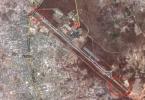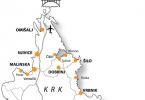Kyrgyzstan is unique country in a world that, so to speak, is all in the mountains. Judge for yourself, the lowest point in Kyrgyzstan is at an altitude of 132 meters above sea level, and the territory below 1000 meters above sea level is only 5.8 percent of the entire territory of Kyrgyzstan.
Suusamyr mountains

Majestic Pamir Mountains
For information, 22.6 percent of the country's territory is located at an altitude of 1 to 2 km above sea level, a little more than 30 percent - at a level of 2 to 3 km, 34 percent - from 3 to 4 km and 7 percent - at an altitude of more than 4 km from sea level.

Scarlet poppies against the backdrop of the snow-white mountains of the Kyrgyz Alatoo
In this regard, Kyrgyzstan is a favorite place for pilgrimage for many climbers, lovers of mountain active rest, as well as supporters of now fashionable ecotourism. For these purposes, Kyrgyzstan has the entire list of necessary attributes. In particular, there are numerous mountain peaks and peaks, designed both for beginner climbers and those with a high passability category. There are countless different mountain routes at your service, which are accessible even for small children. And the beautiful landscapes opening from the mountains, striking in their beauty, will not leave anyone indifferent.

Alpine lake Karasuu
But most importantly, all the mountains of Kyrgyzstan are located in close proximity to passable transport routes, which makes them even more accessible.

"Fairy Tale" Teskey Alatoo

Kyrgyz horsemen on the background of the Talas mountains
The main mountain systems of Kyrgyzstan
The mountains of Kyrgyzstan belong to the mountain systems of the mighty Tien Shan and no less majestic Pamir. At the same time, the Tien Shan, which in translation means "heavenly mountains", occupies a significant part of the country's territory.

The majestic overcloud peak of Pobeda

Khan-Tengri is one of the seven-thousanders Central Asia
On the territory of Kyrgyzstan there are 3 out of 5 seven-thousanders of Central Asia, in particular, Pobeda Peak (7439 meters above sea level), Lenin Peak (7134 meters) and Khan-Tengri Peak (7010 meters). Two more seven-thousanders are located in Tajikistan (Communism peak - 7495 m. and Korzhenevsky peak - 7105 m.). For your information, climbers who have conquered all the indicated 5 seven-thousanders receive the honorary title "Snow Leopard" and the corresponding certificate.

Kemin mountains

Snow-white peaks of Teskey Ala-Tau
The main mountain ranges on the territory of Kyrgyzstan are the following (sorted by the length of the range):
|
Ridge name |
Length (in km) | Width (in km) | Average height above sea level (in m.) | Highest I ridge point |
|
Kakshaal-too |
582 | 54 | 4500 |
Pobeda Peak (7439m) |
|
Kyrgyz |
454 | 40 | 3700 |
West Alamedin Peak (4855m) |
|
Teskey Alatoo |
354 | 40 | 4290 |
Karakol (5280m) |
| 350 | 20 | 4450 | Tandykul (5880m) | |
|
Turkestan |
300 | 30 | 4430 |
Sabla Peak (5621m) |
|
Kungei Alatoo |
285 | 32 | 4200 | Chok-Tal (4771m) |
| Talas | 260 | 40 | 3930 |
Manas Peak (4488m) |
| 250 | 40 | 5460 | Peak Lenin (7134m) | |
| Chatkal | 225 | 30 | 3800 |
Chatkal-Aflatun (4503m) |
| 206 | 62 | 3620 | Kara-Kulzha (4940m) | |
| At-Bashi | 140 | 30 | 4300 |
Erme (4786m) |
It is located within the Tien Shan mountain system and is larger in area, and its southwestern part is within the Pamir-Alai mountain system.
Delightful landscape of mountains and lake in Kyrgyzstan
The most important mountain objects of Kyrgyzstan are the following: the Akshiyrak massif, the Kokshal-Too mountain range ( highest point- Dankov Peak, 5982 m above sea level), the Kyrgyz Range, the Kungei Ala-Too Mountain Range and the Fergana Mountain Range.
And the most important mountain objects of the western part Kyrgyzstan, which is located respectively within the western mountain range Tien Shan are: the Talas Ala-Too ridge, the Chatkal ridge, as well as the picturesque Talas valley.
In the southern part Kyrgyzstan and there are: the northern slope of the Turkestan ridge, the Alai mountain range, as well as the Alai valley of the same name and the northern mountain slope of the Zaalai ridge (Lenin Peak, 7134 m above sea level), which constitutes the northern majestic outskirts of the Pamir mountain system.
In the southwestern part of the country Kyrgyzstan located: northern, southern and eastern outskirts of the picturesque Fergana basin with adjacent foothills.

Impressive mountains on the way from Osh to Naryn

The picturesque slopes of the mountains of the Karakol resort

Mountains in Jeti Oguz National Park
Kirghiz giants, stone giants, great heroes forever turned into idols, every day trying to prove to themselves and to each other that they are not only higher than the sun itself, but can reach the farthest star with their ice top. So what am I on about? Oh yes, about the mighty, invincible Kyrgyz mountains - Tien Shan and Pamir.
The “Heavenly Mountains” (as the name “Tien Shan” is translated from Chinese) stretch in long chains from west to east with 88 powerful ridges. In their central part - the Central Tien Shan - are located the most high peaks Kyrgyzstan -, whose height is 7439 meters, and, with a height of 6995 meters.
The Tien Shan Range is the longest range not only in Kyrgyzstan, but throughout Asia. Its length is 2800 km, width is 800 km. In addition to the Khan-Tengri and Pobeda peaks, there are about 40 more peaks over 6000 meters high on the ridge. The ridge covers several states, but for the most part lies on the territory. It is divided into the following zones: Central, Northern, Western, Southwestern, Inner and Eastern Tien Shan. Each of these zones is of a characteristic alpine type.
The Tien Shan mountains have a considerable area of glaciation - 10.2 thousand square kilometers. The largest area of glaciation here is located in the ridges of the Central Tien Shan. Other centers are the Zailiysky Alatau, Terskey-Alatau, Akshiirak, Kokshaltau ridges, and in the Eastern Tien Shan - the Iren-Khabyrga and Khalyktau ridges. Complex valley glaciers flow down from the ridges of the Central Tien Shan; the largest of them - (its length is 59.5 km), (38.2 km) and the most significant glacier of the entire Eastern Tien Shan - Kara-Dzhailau (34 km).
The first mention of the Tien Shan Range appeared in antiquity. According to ancient writings and notes of travelers, expeditions to these places have been made since ancient times, but now they all look more like legends than reliable ones. historical facts. The expedition of the Russian explorer Pyotr Semenov in the middle of the 19th century for the first time shed light on the mystery of the "Celestial Mountains". Thanks to his research, Semyonov even received a second honorary surname from the tsar - Tien Shansky.
Now with regard to the legendary mountains of the Pamirs. Kyrgyzstan has only the most Northern part Pamir, represented northern slopes The Trans-Alay Range and the northern part of the Pamir-Alay - the mountains that separate the Pamir and the Tien Shan and which include the Turkestan and Alai Ranges. Among these ranges, the Zaalai (the northern border of the Pamirs) stands out, stretching for 200 km from west to east, from the confluence of the Muksu and Kyzylsu rivers to the Irkeshtam peak on the border with China and further along Chinese territory for another 50 km. Its average height is 5500 m. And it is famous for the fact that its highest point is the legendary and beloved in climbing circles, whose height is 7134 meters.
So, three Kyrgyz seven-thousanders:
1.
2.
3. (up to seven thousand, this peak lacks only five meters, but based on the fact that in terms of climbing difficulty it is in no way inferior to the seven thousandth peak, it was decided to give it this honorary status).
Lower peaks in Kyrgyzstan, most often used for trekking:
Peak Adygene (4393 m) - located on the territory national park Ala-Archa, height;
Peak Chapaev (6371 m) - located in the Central Tien Shan, in the Muztag massif;
Crown Peak (4860 m) - located on the territory of the Ala-Archa National Park;
Gorky Peak (6050 m) - lies in the Pobeda massif;
Svobodnaya Korea Peak - located on the Ak-Sai Ridge in the Ala-rcha National Park;
Peak Karakol (5216 m) - located in the Oguz Bashi massif on south coast Lake Issyk-Kul;
Peak Manas (4482 m) - the highest point of the Talas Range;
Peak Marble Wall (6400 m) - located in the Central Tien Shan, in the Muztag massif;
At the foot of the snow-white mountains of the Kyrgyz Ala-Too, at an altitude of 750 m above sea level, 25 km from the border with Kazakhstan. This is the soul and heart of the Republic in the full sense of the word, its political, economic, scientific and Cultural Center, the main transport hub.
The population of the city according to the data for 2010 is 846.5 thousand inhabitants. Unlike southern regions Republic, a high percentage of the population are Russian and Russian-speaking residents.
Bishkek by climatic conditions occupies the extreme southern position in the continental climate of temperate latitudes. The monthly duration of sunshine is greatest in July - 322 hours, the smallest in December - 126 hours. The climate in Bishkek is sharply continental, the average annual air temperature is +10.2°C. The coldest month of the year is January (-4°C), the warmest is July (+24.7°C). The average monthly relative humidity rises from 44% in June and July to 74% in March. The rivers Ala-Archa, Alamedin and the Big Chuisky Canal flow through the city.
The capital of Kyrgyzstan is a unique young city of a unique and mysterious mountainous country. Yes, perhaps there are no ancient or medieval historical monuments, but this is absolutely no reason to consider this city boring and uninteresting. You can’t blame, for example, a child for being small. As for Bishkek, the city was founded only in 1825, and this is no more than a second for history. Therefore, for lack of a past, the Kyrgyz capital, accordingly, has no monuments of the past. Where do they come from? Nevertheless, the city is quite interesting, beautiful and unusually friendly. And very special and unique emotions arise at the sight of the majestic and alluring ridge of the Kyrgyz Alatau. Therefore, being in the city, it is quite difficult not to succumb to the temptation and not to rush to the mountains at any convenient opportunity.
An individual feature of the city is the strict layout of the streets, which intersect only at right angles. Residents of the capital are always proud of the fact that these streets are densely planted with trees and shrubs, which creates a special comfort and life-giving coolness. Therefore, it is not for nothing that they say that Bishkek is one of the greenest cities in the world.
Bishkek is the center of the national culture of Kyrgyzstan. Visitors are always welcome museum Fine Arts, museum to them. M.V. Frunze, the Opera and Ballet Theatre, Russian and Kyrgyz Drama Theatres, the Bishkek City Drama Theatre, the building of the State Philharmonic named after. T. Satylganova and other places for fun leisure activities.
Science and education in the capital is represented by the National Academy of Sciences and a large number of specialized secondary and higher educational institutions. Among them are 18 universities, 20 institutes, 9 academies, which annually graduate up to 5.5 thousand qualified specialists.
 Name
Name
A variety of legends have been circulating about the name of the city for hundreds of years. According to one version, "Bishkek" is the name of the local hero, Bishkek-Baatyr, who did a lot of good for the common people, he lived here in the 18th century.
In general, the word "Bishkek" from Kyrgyz means "a stirrer for whipping koumiss (a drink obtained from mare's milk)."
But, in addition, according to some historians and writers, the word "Bishkek" means "the front, front part of a happy, beautiful mountain (Mount Baitik), as well as a five-walled fortress."
City `s history
The city of Bishkek (to be more precise, the territory on which the modern city is located) has been known since the 7th century as the settlement of Dzhul (Blacksmith's Fortress).
However, it was only in 1825 that the Kokand fortress Pishpek was formed on the territory of the Chui valley, which housed the largest garrison. Twice - September 4, 1860 and October 24, 1862 - the fortress was taken by Russian troops. In November 1862, it was destroyed, and two years later a Cossack picket was set up in its place, then a bazaar began to gather here. Later, already in April 1878, in connection with the transfer of the county center to Pishpek, the village received the status of a city.
 From October 1924, the city became the administrative center of the Kara-Kyrgyz Autonomous Region, then the administrative center of the Kirghiz Autonomous Region. In 1926, Pishpek was renamed Frunze in honor of a native of the city, a Soviet military leader. Since 1936, Frunze had the status of the capital of the Kirghiz SSR. And after gaining independence, on February 1, 1991, by decision of the Supreme Council of Kyrgyzstan, the city was renamed Bishkek.
From October 1924, the city became the administrative center of the Kara-Kyrgyz Autonomous Region, then the administrative center of the Kirghiz Autonomous Region. In 1926, Pishpek was renamed Frunze in honor of a native of the city, a Soviet military leader. Since 1936, Frunze had the status of the capital of the Kirghiz SSR. And after gaining independence, on February 1, 1991, by decision of the Supreme Council of Kyrgyzstan, the city was renamed Bishkek.
Tourism
Bishkek, being the center international tourism in Kyrgyzstan, often serves as a transit point and a resting place on the way to or and at the same time can offer tourists a large number of attractions.
Main and favorite place recreation and walks for guests and tourists of the capital - this is the center of Bishkek. Most of the museums, galleries, shops, parks, squares, squares, restaurants and cafes are concentrated here. By the way, Bishkek is the only city in Central Asia where a monument to Lenin stands to this day. True, now it is located not on the main square, but behind it, but even this is already a striking difference from other cities in the Central Asian region.
The city has 20 national parks, 4 artificial reservoirs, 6 swimming pools, 10 theaters, 5 memorial museums under open sky, 8 specialized museums, as well as other squares of culture and recreation.
One of these objects is the oak park, where it is always cool under the dense crowns of trees, and fluffy frisky squirrels scurry along the trunks, peering into the faces of vacationers in anticipation of getting a treat. Oak Park is a kind of open-air sculpture museum. Sculptures made in stone, metal and wood are located here alone and in groups along park alleys, paths, and some are simply among the trees on green lawns.
 Adjacent to the oak park is the so-called "Bishkek Vernissage" - Erkindik Gallery, where you can admire the work of local craftsmen and artists.
Adjacent to the oak park is the so-called "Bishkek Vernissage" - Erkindik Gallery, where you can admire the work of local craftsmen and artists.
Behind the gallery opens the main square of the country - Ala-Too. Ala-Too Square is fraught with great tourism potential - the white marble Government House is located here. The square is decorated with fountains, a stage has been built right there, where mass concerts and discos are held. It is here that people flock in mass during holidays and festivities. There are also military parades and demonstrations.
The sights of the capital include the Museum of Art, which exhibits exhibits of Kyrgyz folk art and modern Russian and Soviet art. Some paintings and exhibits try to combine Kyrgyz images and European technology. There are also examples of elegant traditional Kyrgyz wall carpets (tushkiis, bashtiyks) of various sizes.
The Bishkek Philharmonic hosts concerts of classical and modern Western music, as well as concerts of Kyrgyz traditional and popular music. The Philharmonic Hall consists of two halls, the larger of which is usually used for concerts of Kyrgyz music and various shows.
The shops of the capital can offer tourists a variety of souvenirs and folk art products produced in such large organizations as "Kyyal", NGO "Zengi-Baba", "Altyn-Beshik", "Shaarbek", which constantly hold exhibitions and fairs of souvenirs and decorative products. applied art in the squares of the city.
Also, tourists here, in Bishkek, will not only be able to relax in yurts, get acquainted with the applied art of the nomadic Kyrgyz people, gain impressions of national customs, cooking, games, taste Kyrgyz cuisine, purchase souvenirs of folk crafts, but also get information about tourist routes throughout the republic.  In Bishkek, as in any other Central Asian city, one of the most striking sights is the oriental bazaar, where generous gifts of the earth and goods from all over the world are presented in abundance at any time of the year, and you can also admire the beauty of mosques and Orthodox cathedrals here.
In Bishkek, as in any other Central Asian city, one of the most striking sights is the oriental bazaar, where generous gifts of the earth and goods from all over the world are presented in abundance at any time of the year, and you can also admire the beauty of mosques and Orthodox cathedrals here.
Sights of the surroundings
Baytyk Valley - stretched behind the counters, which rests on the southern outskirts of the city. The valley is called so in honor of its former owner - the manap of the Kyrgyz tribe Orlto - Baityk Kanaev, who at one time contributed to the voluntary entry of Kyrgyzstan into Russia. Part of the slopes of the valley is planted with pistachios, while the other is in a natural state. There are a lot of bird species here. To the south-west of VDNKh of Kyrgyzstan there is Mount Boz-Peldek (1395 m), which can be reached by city buses. From its top, like a plan on paper, you can see the whole city.
Khan's Graves is a Kyrgyz cemetery located at the southern foot of Mount Boz-Peldek. The former ruler of the Baityk valley and his son Uzbek are buried here, over whose grave a magnificent wrought-iron lattice tower with a dome was erected.
Chon-Aryk State Botanical Preserve is located southeast of the city in the Besh-Kyungei tract. Plants such as Alatavian saffron, Kolpakovsky's iris, Kumakevich's juno, several types of tulips and others are strictly protected here. The surroundings of the city are rich in mineral springs.
The deposit of peat therapeutic mud is located near the village of Kamyshanovka. Therapeutic mud is used here to treat the supporting organs, the peripheral nervous system, the respiratory system, the gastrointestinal tract, and gynecological diseases.
Photos:
 |
 |
 |
 |













Our video gallery:
| Other sights of Kyrgyzstan: | In which tour you can see Bishkek and other sights of Kyrgyzstan: | |||||||||||||||||||||
|
| ||||||||||||||||||||||




